ENTS
Carl Harting and I visited an area known as Chestnut Ridge just
east of
route 321 a couple miles east of the Allegheny Reservoir,
colloquially
known as Kinzua Dam.
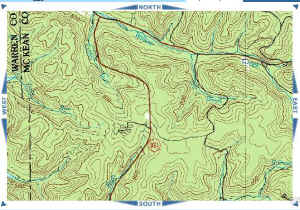
Maps of areas from mapquest |
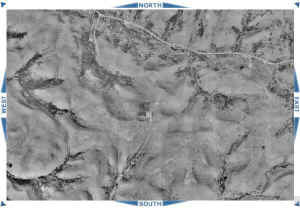 |
We parked beside the road and headed into
the forest
going east and little southward. We found ourselves in a young
second
growth forest. I estimated 30 years, Carl 50 years. It consisted
of an
overstory dominated by white oak. The understory was heavily
populated by
striped maple, cucumbertree, and American Chestnut. The chestnut
trees were
everywhere. Most were less than 20 feet high with some
individuals going as
tall as 40 feet. The trunks all were small in diameter. Soon we
found an
old overgrown road and decided to follow it across the ridge.
The road ran
eastward and slowly curved slightly to the north. Here and there
were
larger specimens of American Chestnut, Some reaching an
estimated 50 feet.
The tallest we measured was (71.3 feet tall and 2 ˝ feet in
circumference).
It is not what I would have expected, but as you walk upon them
at first
cucumber trees look remarkably like chestnuts until you are
close enough to
discern the differences. Perhaps they have a similar branch
pattern, or
leaf out pattern, but at first glance they look very much alike.
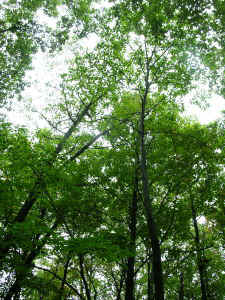
Largest American Chestnut measured. |
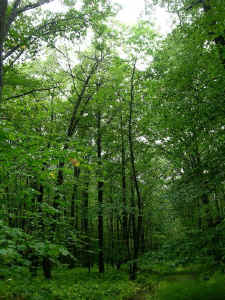 |
[Carl notes: I'd like to add chestnut oak
into the mix of trees that the
chestnuts were associated with. They may not have been quite as
numerous
as
the cucumbers and other oaks, but they were definitely there.
While the
cucumber and striped maple are missing in the chestnut habitat
on the ridges
above the Clarion River, the chestnut and other oaks are present
there.
Chestnut oak are also very difficult (at least for me) to
differentiate from
American chestnut at a distance, especially when the bark is not
visible.
The trio of Am Chestnut, chestnut oak and cucumber at this site
was tough to
read quickly. As with the other chestnut sites, the chestnuts
were only
found on the ridges, never in the valleys.]
It had been raining earlier in the day, and I had not been sure
the trip
would go off as planned. I met Carl at Cook Forest and we car
pooled to the
site. I brought my raingear. It turned out that
we avoided most of the
showers and had a pleasant day for the walk. It had rained for
several
days. Mushrooms and fungus were growing everywhere. There were
numerous
frilly orange unidentified species, browns, white, purples and
reds. I saw
at least two varieties of coral fungus.
From there we continued along the road looking for taller
specimens with
little luck. After a short distance we arrived at a dirt and
gravel road
trending north. We followed this road and began a slow descent
from the
ridgetop. As we descended the types of trees changed to one
containing more
red oaks, maples, and a few tuliptrees and bigtooth aspen. We
stopped and
measured a couple of them, but no records were set. I was still
amazed at
the variety of fungi growing in the area. Even
in this out of the way
stretch of road there were still occasional piles of trash down
th hill
slope from the road. One had a number of cans and several
plastic 5 gallon
plastic buckets.
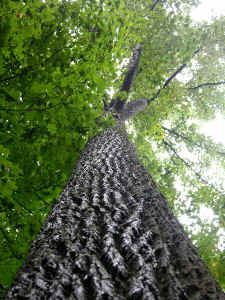
Tuliptree |
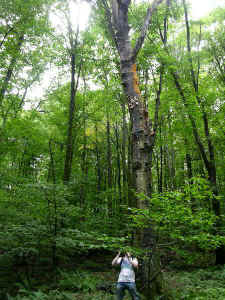
Dead tree with fungus growth |
As we approached the bottom of the hill a stream grew nearer to
the road.
In the bottom portion of this journey we started to find some
hemlock,
hornbeams and a few others. At this point we decided the road
was not going
the correct direction as shown on my GPS unit map, so we took
off and headed
cross country westward. Route 321 was a little over a half mile
in that
direction.
[Carl notes: the heights of the small area
of taller trees, and mention
that this forest was older than that found on the ridge top (at
least it
looked a good bit older to me, especially with the red maple
having the
shaggy bark and the large oaks were found as we were climbing
out of the
valley).]
tallest chestnut CBH 2ft 6in height 71.3 feet
tulip CBH 8ft 2in height 125.1ft
white ash CBH 4ft 8in height 114.5ft
bigtooth aspen CBH 4ft 9 in height 96.1ft
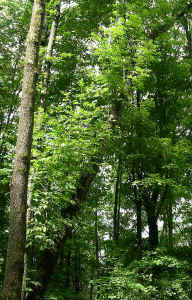
Tree with a series of branches growing out of its
side from epicornic sprouts. |
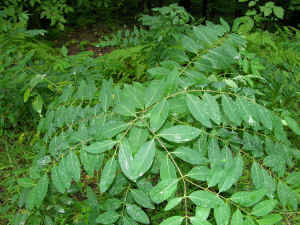
Roadside Plant: Alianthus? |
A short distance into the woods we cam across a stream. It did
not look
very wide or deep, but was flowing pretty rapidly. We decided to
cross anyway.
Going cross-country was not the best idea I ever had. All of the
elevation we l
ost up to that point, was regained in this single climb. I had to stop
several times
and catch my breath, those overhangs are murder. During one of
those pauses
a hawk flew down from a tree very agitated near Carl, but did
not see it
engrossed in the examination of a tree on the hillside. It flew
off.
Once we reached the top, it was a a fairly straightforward shot
back to
route 321. On the flats we again started to encounter striped
maple,
cucumbertree, and chestnut. Here also were some tuliptrees and
beeches,
with overstory white and red oaks. I wondered about the
association between
the striped maple, cucumbertree, and American chestnut. It
seemed to be the
norm here, but was not the same at other chestnut locations we
had visited.
Perhaps it was coincidental. Soon we were back at the road. It
was a short
walk along the highway back to the car. We arrived just as the
rains
started to fall.
Immediately south along the road we turned into the the Tracy
Ridge
Campground for a quick drive through on the same ridge for a
quick look.
The place had hundreds of American Chestnut trees. Most were
small, a
couple we saw from the car might have reached 50 feet. Given the
number we
saw, and the fact that wee found a 71+ footer elsewhere on the
ridge, it
would be worthwhile to revisit the campground area for a
reconnaissance of
chestnuts and other trees present. From here we head back to
Cook Forest
and on to home.
This was our trip more or less. Nothing really exciting or
unusual
happened. We found some interesting forest, but nothing really
old or big.
This had to be the densest population of American Chestnut I had
ever seen.
Some reports suggested in areas that American Chestnut had made
up to 70%
of
the basal area in given stretches of the forest. None of the
trees looked
mature enough to produce nuts and were likely root sprouts. If
the blight
doesn’t get them they may produce nuts in a few years. With
such a high
density of trees there is even a good chance of pollination from
other
individuals and the production of viable nuts. Keep your fingers
crossed.
Ed Frank
Sept 14, 2006
|